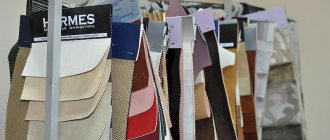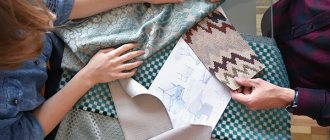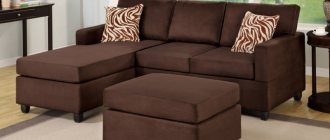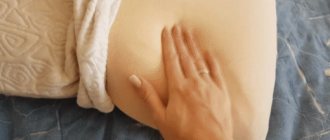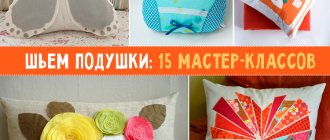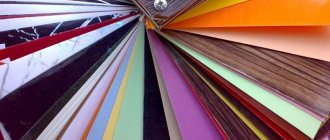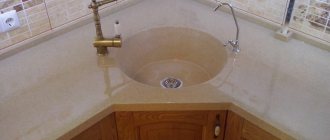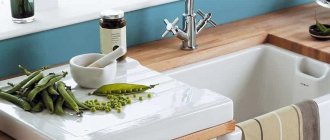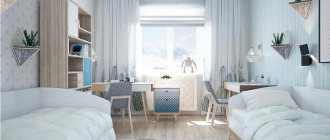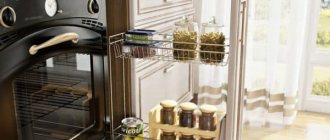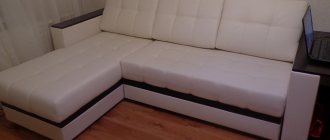If you want your pillow to last for many years, choose the right fabric for the pillowcase. It is a cover that holds the filler inside, preventing it from caking and causing discomfort to human skin. The pillowcase is also called an intermediate pillowcase. Listed below are the pros and cons of fabrics that are often used when sewing pillows.
General rules for choosing fabric for a bedspread
When choosing fabric for a pillow cover, you must clearly understand for what purpose you will use the product. If you are making bedding, focus on natural materials that “breathe” and quickly remove moisture. For sofa and other decorative pillows, any abrasion-resistant fabric is suitable.
In addition, when choosing a material, you need to consider the following factors:
- Filler type
Feather and down filling requires a durable intermediate pillowcase. Otherwise, it will crawl out of the napkin and stab your face. But synthetic fiber (sintepon, foam rubber, holofiber) can be placed in a thin and soft fabric that does not accumulate static electricity.
- Residents' health
For allergy sufferers and asthmatics, it is better to sew a pillow made of cotton, linen or bamboo. Such materials themselves are hypoallergenic and also insulate the filler well.
- Interior
Fabric for decorative pillows should be selected taking into account your taste and the style in which the room is decorated. For example, the atmosphere of luxury is emphasized by jacquard and velor products. And in an elegantly romantic bedroom, pillows made of cambric, silk, and satin are appropriate.
What is used to stuff sofa cushions?
The padding is just as important for a sofa cushion, as is the fabric from which it is made. There are several dozen types of fillers that can be used to fill textiles. They differ in composition, degree of creasing, durability, and washability. How to choose the most suitable one? We invite you to familiarize yourself with the factors necessary for the correct selection.
- Purpose of use. If the pillow will serve only as a decorative element, there is no point in purchasing natural, expensive materials. It can be filled with budget padding polyester, advanced holofiber, or for rigidity and shape - with PU foam crumbs. If you want to have a universal cushion on which you can lie and decorate your sofa at the same time, use sheep wool, natural latex or silicone for stuffing.
- Hypoallergenic. Allergies, asthma, and other similar diseases of the upper respiratory tract do not allow you to take the choice of padding lightly, because it can provoke an unpleasant and even dangerous reaction. Be sure to keep in mind that natural fillers (down, feathers, sheep wool, herbal infusions to improve sleep) are allergenic; it is better to replace them with holofiber or comforter.
- Rigidity. For many people, this factor is of paramount importance, so we suggest dividing fillers by degree of hardness. So, natural latex, silk, and down will be soft and enveloping. More solid, with shape support - silicone, PU foam crumbs.
- Washable. If you are sewn a pillow without a cover, sooner or later you will need to wash it, but this cannot be done with every filler. Natural fillings do not tolerate large amounts of moisture and are damaged by it. Therefore, you can only wash a roller with synthetics - padding polyester, holofiber, silicone.
- Budget. A significant factor that directly influences the choice of filler. So, if funds are limited, you can use padding polyester - an inexpensive, moderately crumpling material, or experiment with natural, cheap cotton wool. But don't expect a long service life from it. If there are no budget restrictions, the above factors will help you decide on the necessary padding.
What fabrics are suitable for pillow covers?
Incorrectly selected filling and bedding will ruin a night's rest even for a healthy person. And regular use of such products will result in problems with the neck, skin, and nervous system. Therefore, below we will consider the materials from which sleeping pillows are usually made.
Teak
Teak is the most popular material for feather pillows. It is a very durable twill or plain weave fabric. It can be natural (from cotton, flax, hemp fibers) and synthetic. Often has a moisture-repellent impregnation.
Teak has the following advantages:
- high density – 140–160 g/m²;
- hygienic and hypoallergenic;
- The filler holds its shape well;
- "breathes";
- serves for decades.
However, such material accumulates moisture over time. Therefore, pillows made from it must be dried periodically in the sun.
Satin
Satin is produced by double weaving twisted cotton threads. Thanks to its thinness, lightness and smoothness, it looks as elegant as silk, although it costs much less.
Satin has the following advantages:
- hypoallergenic;
- pleasant to the touch and comfortable for the skin;
- quickly removes moisture;
- "breathes";
- can withstand washing up to 95°C;
- does not wrinkle.
The material is ideal for pillows with synthetic and down fillings, decorative items, and pillowcases. But for the pen you should choose a different option. In addition, satin is highly electrified.
Linen
One of the most durable and wear-resistant fabrics, moreover, perfectly breathable. Does not accumulate dust mites, fungi and bacteria. Linen is an excellent material for children's cushions, products for the elderly and allergy sufferers.
Some people find the fabric rough to the touch. However, there are more delicate items made from linen and cotton on sale.
Bamboo
Bamboo is a natural material of plant origin. It is thin, smooth and pleasant to the touch. It removes moisture well and has pronounced antibacterial properties. Ideal for people with sensitive skin.
In terms of durability, bamboo is superior to cotton and satin. Nests made from this material do not wrinkle or stretch even after repeated washings.
Wool
Fabric containing wool fibers retains heat well. Therefore, it is useful for people with neck diseases, in particular osteochondrosis.
However, wool has a number of disadvantages:
- may prick the face;
- prone to shrinkage after washing;
- highly electrified.
It is better to use this fabric for decorative or outdoor pillows. It will create a cozy atmosphere.
Silk
Since ancient times, only noble people slept on silk pillows. And today such fabric is the most expensive. Silk is very thin, light and has a pearlescent sheen. Thanks to its incredible smoothness, it does not create creases on the skin of a sleeping person and does not injure the hair. Natural fibers are considered hypoallergenic.
However, silk cannot be combined with feather, down, or wool fillings. In addition, delicate fabric is difficult to care for.
Batiste
What fabric can replace silk in the bedroom? Lawn is considered a worthy competitor. This is a translucent, light, almost “airy” fabric. It is made from cotton or synthetic threads. It is not hot to sleep on a cambric pillow in summer, and not cold in winter. The skin “breathes” during sleep, does not sweat and is not irritated.
The disadvantages of cambric are the same as those of silk: it does not combine with feather filling and is demanding to care for.
Twill
Twill is a twill weave fabric that is delicate and soft to the touch. Outwardly it resembles satin, but less dense. As a rule, the material has a mixed composition of natural and synthetic fibers (for example, cotton + acrylic or wool + polyester).
Twill pillows hold their shape perfectly, look elastic and voluminous. Comfort during sleep depends on the composition of the product.
Percale
It is considered one of the best fabrics for bed linen. Smooth, soft to the touch, yet durable and wear-resistant. That is, percale combines the advantages of two materials at once: teak and satin. Suitable even for feather filled pillows.
Jacquard
Jacquard is a noble, elegant material with a patterned design and glossy shine. Typically used as a fabric for decorative pillows. Jacquard is very durable, does not deform or wear out for years. However, sleeping on it is not very comfortable due to the textured surface.
Case decor
You can decorate pillows with a variety of applications.
You can create an exclusive and interesting thing with the help of decor. The following are considered the simplest elements of jewelry.
- Using braid. This is a narrow, thin strip with patterns. It is used both for upholstery of sofas and interior units. The braid can be embroidered using different techniques at home.
- Using scallops. A strip with patterns of leaves, geometric shapes and other ornaments is sewn on the front side.
- Sewing various mosaics from small pieces of fabric. It is called the patchwork type of sewing.
- Decoration with accessories - buttons, beads, glass beads. In children's rooms you can find rollers decorated with representatives of the animal world; the figures are attached using Velcro.
- Print. The fabric is coated with durable paint that cannot be washed off. Such decorative pillows are well suited for summer terraces and balconies. They don't look boring and don't fade in the sun. They also do not absorb liquid well, so sudden rain is not a problem.
You can make a pillow cover with ribbon embroidery, it will look unique and very beautiful.
What fabrics are suitable for decorative pillows?
A decorative pillow can be sewn from the same materials as the bedding. But it is better to opt for those options that will emphasize the unique style of the owners of the house:
- Fabrics for furniture upholstery
Pillows made of flock, chenille, corduroy, velor and other fleecy fabrics create an atmosphere of homely warmth. Such products can be additionally decorated with ribbons, buttons or appliqués.
- Fur
Fur pillows scattered on the sofa look cute and warm during the cold season. True, they need to be vacuumed regularly.
- Old clothes
A pillow made from leftover fabric from old clothes (jeans, knitted blouses and dresses, fleece) looks unusual. You can experiment with colors, sizes, shapes and create a product that you won’t find in any store.
Care
Despite the fact that decorative pillows are used relatively rarely (less often than specialized bedding), they also require care to maintain an aesthetic appearance. Since completely different materials are used, the care conditions vary in each specific case. That is why, before washing a product or performing any other manipulations, you need to read the information on the label or on the original packaging - there may be important information prohibiting, for example, home washing or the use of high temperatures.
There are several rules suitable for caring for any decorative sofa pillow:
- if moisture gets on the product, it must be blotted with an absorbent cloth and dried;
- From time to time, pillows should be fluffed, shaken off dust and, if size and material allows, vacuumed;
- products must be protected from sunlight - if light falls on the sofa, the fabric may fade;
- sofa cushions should be ventilated at least once a season on the balcony or outdoors in the shade;
- It is better to dry-clean items with rich decor so as not to damage them during home washing;
- When buying a decorative pillow, give preference to models that are equipped with a removable cover, because it can be conveniently washed in a regular washing machine without touching or damaging the filling.
Decorative pillows are an easy way to decorate a sofa and add variety to your interior. Soft textile accessories will also be comfortable while reading or drinking tea, because you can lean on them. In the summer, sofa cushions can be taken outside to serve as a hammock or gazebo. A huge selection of modern fabrics, fillings and decor options allows you to choose a product to suit every taste, for any interior.
How to sew a pillow at home?
On the Internet you can find detailed instructions on how to sew decorative and sleeping pillows. In general, the needlework process includes three stages: determining the dimensions, preparing the pattern and making the bedspread.
How much fabric do you need for a pillow?
Before you calculate the fabric for the pillow, you need to decide on the dimensions of the future product.
Today the standards are:
- 60 × 60 cm;
- 50 × 70 cm.
For them you will need fabric 65 cm long and 150–170 cm wide. It is then easy to choose pillowcases for such products.
How to make a bedstead?
After determining the dimensions, it is necessary to cut out a rectangle along the transverse line of the fabric, leaving seam allowances of 1.5–2 cm. The workpiece should be folded in half and ironed. Sew open sections around with an overlocker. Then fold the product with the front part inward and sew the seams. Don't forget to leave a hole on one of the sides of the bedstead.
In the end, all that remains is to fill the pillow with filler and sew it up using a typewriter. If desired, decorate with decorative elements.
Third stage
DIY ready-made pillowcases for sofa cushions
When everything is ready, turn the pillowcase inside out and proceed to decoding. Please note that the parameters of the pillowcase should be a couple of centimeters larger than the base. This makes it easier to remove when cleaning.
Photos of our sofa cushions in the interior
Patterns
For your convenience, we have posted some patterns of popular models of decorative pillows:
- Pattern of a decorative pillow - “sleeping kitten”.
- Pattern of a decorative pillow - “cat”.
- Pattern of a decorative pillow - “letters”.
- Decorative pillow pattern - “Owl”.
- The pattern of the decorative pillow is “whale”.
In a single article it is impossible to list all the existing types of decorative pillows, because human imagination is limitless and every housewife will invent her own separate version. We tried to list the most common types of decorative pillows and hope that you found something useful for yourself.
What should you not do when sewing pillows for country furniture?
- Use natural fabrics and natural fillers - some fade instantly, others take on a new life (fungi, mold, bugs).
- If you combine several different fillings in one product, such a pillow will quickly lose its shape.
- Filling a pillow with old filling (cotton wool, fur coats, mattress fillings) will lead to lumps and lumps in the pillow.
- When sewing, use thin or poor quality threads - such a pillow will very quickly collapse at the seams.
Tools
The main tool of any seamstress is, of course, a sewing machine. But if you don’t have one, then you shouldn’t be upset; a decorative pillow can be made by hand, it just takes more time. Referring to the list below, prepare the following tools:
- Set of needles.
- Scissors.
- Marker, chalk or pencil.
- Paper for patterns.
- Knitting needles or hook (if a knitted product is being made).
- Iron.
- Tailor's meter.
Set of tools
How to decorate chair pads
Original do-it-yourself cushion-cover for a chair - step-by-step instructions
In order to make the interior more expensive, you can create quilted products with your own hands.
